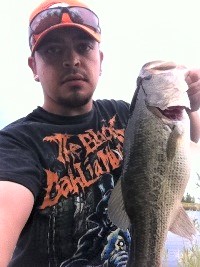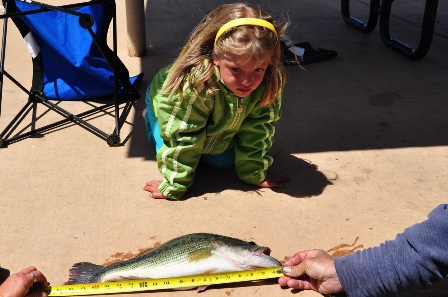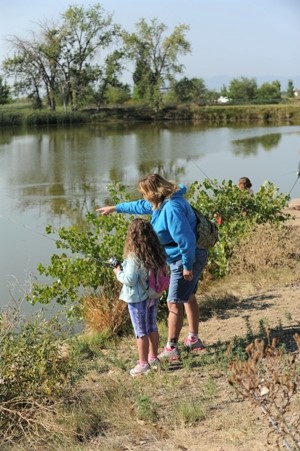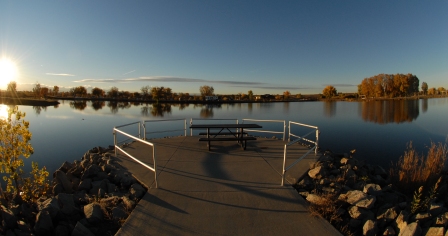Fishing is one of the most popular activities at St. Vrain State Park. As such, we strive to make this experience enjoyable and successful for the anglers who visit the park. With fish species such as bluegill and black crappie, young anglers can hone their fishing skills before moving up to rainbow trout, and channel catfish. Check out our Fish of St. Vrain Brochure to see a list of the most common fish species inhabiting the ponds in the park. In addition, we offer the perfect environment for ice fishing for those willing to brave the elements!
The ponds at St. Vrain State Park have been a favorite family fishing
destination for decades. Different ponds are stocked with trout, bass, walleye,
and assorted panfish.
Where Can I Find…?
The most
common fishing question heard by the rangers is “What species of fish are in
which ponds?” Based on the stocking reports and fish surveys, here’s a list of the fish you'll find in each pond.
All Known Species:
- Black Bullhead: Blue Heron Reservoir
- Black Crappie: All Ponds, best on Blue Heron, Coot, and Mallard
- Bluegill: All Ponds, best on Blue Heron Reservoir
- Channel Catfish: All Ponds, best on Blue Heron and Pelican
- Common carp: All ponds except Redtail and Avocet
- Gizzard shad: Prolific on Bald Eagle, Blue Heron, Coot, Pintail, Pelican, and Sandpiper
- Grass carp (Sterile): Pelican & Bald Eagle Ponds (very small number of hold-overs from before 2013 flood)
- Green Sunfish: All Ponds, best on Bald Eagle
- Largemouth Bass: All Ponds: best on Bald Eagle and Blue Heron
- Northern Pike: Pintail and Pelican
- Perch: Blue Heron, Pintail, and Coot have historically held Perch, although numbers are low since flood and introduction of other predatory fish such as Saugeye/Walleye and Pike.
- Rainbow Trout: Coot, Mallard, Pelican, and Sandpiper: Oct-April
- Redear Sunfish: All Ponds, best on Blue Heron and Redtail
- Saugeye/Walleye: Blue Heron, Coot, Pelican, Sandpiper
- Tiget Musky: Pelican (also has Pike with very different limits for size and bag/possession limits) (very small number of hold-overs from before 2013 flood if any)
- White Bass: Only known population is on Blue Heron. (White bass do not count for Immediate Catch and Release regulation on this water and may be kept. They are illegally stocked and a nuisance to other species being selectively raised in this fishery, please keep them).
- White sucker – Coot & Pintail Pond
Which Pond is Which?
It’s
important to know which pond you’re fishing at – not only so you catch the right
fish, but so you know you’re fishing legally too!
Bald Eagle Pond and Blue Heron Reservoir are managed for Trophy Bass fishing and have special regulations. Blue Heron also has a special fishing regulation for Catfish.
View a map of the park ponds.
 Beginning where you
turn off Highway 119 onto County Road 7, you’ll see the Blue Heron Reservoir
on the right, and a handful of other ponds on the left. Parking is not allowed on the side of the road anywhere within park boundaries,
beginning just off Highway 119. There are over 120 parking spaces on the east shoreline of the reservoir. Special fishing regulations ae in place on this reservoir: All Largemouth and Smallmouth Bass must be immediately returned to the water, and you may only keep one Catfish that is longer than 20" within your creel limit of 10, all others in possession must be shorter than 20" in length.
Beginning where you
turn off Highway 119 onto County Road 7, you’ll see the Blue Heron Reservoir
on the right, and a handful of other ponds on the left. Parking is not allowed on the side of the road anywhere within park boundaries,
beginning just off Highway 119. There are over 120 parking spaces on the east shoreline of the reservoir. Special fishing regulations ae in place on this reservoir: All Largemouth and Smallmouth Bass must be immediately returned to the water, and you may only keep one Catfish that is longer than 20" within your creel limit of 10, all others in possession must be shorter than 20" in length.
Pintail Pond is immedaitely east of Blue Heron and has a gazebo on the shoreline. Coot Pond to the east and Yellowlegs to the south of Pintail may be accessed from this parking lot as well.
Then as you head east on County Road
24 ½, the park is divided into northern and southern halves. The big pond on
the north side of the road is Sandpiper Pond, with little Killdeer and Avocet
Ponds at the west end. Mallard Pond is right behind the Camper Services
Building and the larger Pelican Pond spans the whole northeastern corner of the
park between I-25 and St. Vrain Creek. It can be accessed from the far east end of the Pelican Campground, or by crossing a footbridge on the northwest side of Mallard Pond.
There is no legal access to St. Vrain Creek on the park.
On the south side of County Road 24 ½, the first big pond you’ll
see is Bald Eagle Pond. Bald Eagle has a large dead tree trunk on an
island in the middle of the pond, which makes it easy to locate. Bald Eagle
Pond has two special fishing regulations – you can only fish with artificial
flies and lures (no bait of any kind!), and if you catch a bass, you must immediately return it to the water.
The smaller pond south
of Bald Eagle Pond and the campground road is Red Tail Pond. Further west
(behind Coot Campground Loop) is Coot Pond, with little Yellow Legs Pond to the
southwest and Pintail Pond to the northwest.

Fishing Regulations
Most of the
ponds at St. Vrain follow the standard Colorado fishing regulations,
including:
Fishing licenses are required for all persons over the age of 16 who are fishing. Any person using 2 rods is required to have an extra rod stamp, even if they are under 16 years of age. Licenses may be purchased at the front entrance or online at CPWshop.com.
- Daily bag and possession limits apply to each species of fish.
Fishing lines must be attended at all times.
Trotlines, jugs, yo-yos and limb lines are illegal in the park.
Chumming is illegal, including during ice fishing.
You may bowfish for Carp, Pike, Shad, Sucker, and Bullfrog.
You may use a cast net or seine to catch baitfish.
You may use a boat, waders, or bellyboat as an aid to fishing.
If ice fishing, you may not fish in a hole wider than 10" diamter, or by breaking shoreline ice.
See the Colorado Fishing Regulations brochure for more details. You can
also get your own copy of these regulations from the park entrance station or
from any fishing license sales agent.
Two bodies of water at St. Vrain
also have specific, more restrictive fishing regulations. These can also be
found in the regulations booklet, and on signs posted around the border of the
ponds. However, in case you miss the signs...
Bald Eagle
Pond:
Fishing is by artificial flies and lures only. Scented flies or scented lures may be used on this water if they are 1.5 inches or longer.
All largemouth and smallmouth bass must be returned to the water immediately upon catch.
Blue Heron Reservoir:
- All largemouth and smallmouth bass must be returned to the water immediately upon catch.
- Only one catfish longer than 20" in length permitted within 10 fish creel limit.
Fishing with Children
 Children under 16 years of age are not required to have a fishing license. However, all
other fishing regulations - including the second rod stamp and bag/possession
limits - still apply.
Children under 16 years of age are not required to have a fishing license. However, all
other fishing regulations - including the second rod stamp and bag/possession
limits - still apply.
Parents or other adults who do not have a fishing
license are permitted to assist children to fish, such as putting bait
on a hook, helping a small child hold the rod, and helping the child cast out.
Children must be actively fishing and attentively monitoring their own fishing
line. If the adult is the only person holding the rod, casting, or
watching the line, then this is illegally fishing without a license or fishing
with too many lines, not "assisting" a child.
Please ask a ranger if you
have any questions about the fishing regulations.
What Should I Use to Catch Fish?
Trout:
When recently stocked, trout will bite on almost anything: flies,
spoons, spinner, crank baits, worms, power bait - even chicken liver. Trout fishing is good from October-May, especially through the ice, when it is safe to fish on. If it
has been a while since the last stocking, it's best to take one of two
approaches:
Use flies, small jigs, spoons, or spinners and stay mobile - cast a few times, move 20-30 feet and cast a few more times.
Use bait - worms, salmon eggs, corn or power bait. When bait fishing, experiment with depths (from just under a bobber to one the bottom) to find where the fish are as well as with different baits to see what they prefer.
Panfish (Bluegill, Redear, Perch, Crappie, Green Sunfish):
Similar tactics to trout, but even smaller. Tiny jigs tipped with worm
or wax worms under a bobber are the best bet; but flies, small spoons and
spinners will also catch panfish when the trout leave them alone long enough.
Small minnows can also be productive when searching for larger
sunfish.
Large and Smallmouth Bass: Spinnerbaits,
plastics and crankbaits tend to be the go-to lures for bass, but don't be afraid
to try a top water or flyfish for bass.
Catfish (Channel
and Bullhead): Bait on the bottom is your best bet. Worms are a
favorite, but stink baits, liver, and corn all work
well.
Carp: Most carp are taken by anglers using baits of all kinds. Carp may also be taken with a fishing bow. Please be mindful of your surroundings and regulations if bow fishing. Carp may also be caught on a fly: try using something that looks like cottonwood seed in June and early July.
Saugeye/Walleye: Most
are taken by anglers using jigs, crankbaits,
spoons or spinners. Some may have success trolling on Blue Heron Reservoir in early spring and early autumn.
Protect Our
Ponds!
Gas powered motorboats may be used and launched by trailers on Blue Heron Reservoir. Make sure your craft is clean, drained, and dry, and be careful to inspect carpeted bunks for invasive plants. There are no ANS inspections at St. Vrain State Park.
Only human-propelled craft, sailboats, and boats with
electric motors that must be hand-launched are permitted on the rest of the park's publicly-accessible ponds. Many
anglers also use waders or belly boats to get out into the water. But did you
know these accessories can spread aquatic nuisance species?
Eurasian
watermilfoil is an invasive plant that can quickly spread and choke out the
aquatic life in a pond. This plant has been found in Mallard Pond, and we need
your help to prevent its spread!
It only takes a single piece of a
milfoil plant to snag on your boots, get dropped into another pond, then grow
and reproduce. Before you take watercraft or equipment into a pond, check it
thoroughly for mud and plant particles that could introduce new unwanted species
into our ponds. Then, after you remove equipment from the water, check it again
and clean off any plant debris to be certain you don’t carry anything to your
next fishing location.
There are native milfoil plants found in several
of the ponds in St. Vrain, which look very similar to Eurasian watermilfoil. The safest measure is to make sure you never carry any plant material between
any bodies of water.
Handicap-Accessible Fishing
Piers

St. Vrain State Park offers a number of handicap-accessible
fishing piers around Sandpiper, Mallard, and Pelican Ponds. These fishing piers
are available for all visitors to use, but please be courteous to your fellow
fishermen and allow space for those with disabilities or limited mobility.
Sandpiper Pond has two concrete piers, on the southern and western
shorelines. Both are located near parking spaces, and are connected to the
parking area by a paved footpath. The southern pier has a restroom close by,
but the western pier does not.
Mallard Pond has a concrete boardwalk with
a safety rail circling the back side of the Barbour Ponds Camper Services
Building. Parking and restrooms are available close by.
Pelican Pond has
three handicap-accessible fishing piers. One is located in Pelican Camp Loop,
across from Sites 12 and 13, with its own parking spaces and a restroom nearby. Two more fishing piers are located off the Pelican Pond Trail - one is just a
few hundred feet up the trail from the eastern trailhead, while the other is
about a quarter-mile in along the northeastern corner of Pelican
Pond.
Fishing Conditions, Stocking Reports, &
Biologists’ Fish Survey
The ponds are typically stocked in late
fall (before ice-over), and in early spring (after ice-melt). The most
up-to-date stocking information can be found on the park's Conditions page.
The annual Fish Survey is
performed by fishery biologists who use a variety of methods like gill-netting
and electroshocking to sample the number, size, and health of the species of
fish in a given pond. The fish survey is analyzed for future use in stocking
and maintaining the fishery, and it is published for the public to see.

